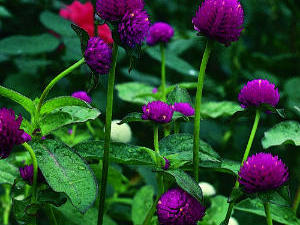
July
What to do in your Mountain garden in July

Plant
Fill gaps in perennial beds. When spring-blooming perennials such as bleeding heart and Oriental poppy go dormant in summer, cut off their yellowed foliage and fill in gaps with annual flowers. When digging the annuals’ planting holes, be careful not to disturb adjacent perennials’ roots.
Replace cool-season annuals. Clarkia, Iceland poppy, lobelia, and stock can’t stand intense summer heat. When they start looking ragged, pull them out and replant beds and containers with heat-loving annuals such as gazania, globe amaranth, Madagascar periwinkle, marigold, petunia, portulaca, sunflower, and zinnia.
Set out irises. Bearded irises can withstand long periods without irrigation, especially when they are dormant in mid- to late summer. Arilbred types and hybrids of Iris pallida are generally more drought- and weather-tolerant than tall bearded types. Two good Colorado sources for bearded irises are Iris Colorado (303/791-0456) in Littleton and Long’s Gardens (866/442-2353) in Boulder.
Maintain
Control spider mites. These tiny red or green pests suck the sap from a variety of ornamental and edible plants, resulting in stippled leaves or distorted flowers. Their numbers increase when conditions are hot and dry. Plants watered by drip irrigation are particularly vulnerable. To prevent infestation, occasionally wash off foliage with a strong jet of water. To control severe infestations, apply lightweight summer oil such as Ultra-Fine (available at garden centers), sulfur dust, or an insecticidal soap labeled for mite control. Be sure to treat the tops and the undersides of the leaves.
For bearded irises, divide overcrowded clumps six weeks after bloom. Dig up rhizomes (thick horizontal roots), cut them into pieces 3 to 4 inches long, and trim leaf fans back to 6 inches. Let them dry in the shade for a few days, then replant 1 foot apart in amended soil. For Oriental poppies, dig up clumps after tops die down. Separate intertwined roots and replant.
After you harvest June-bearing strawberries, apply 2 pounds of 10-10-10 fertilizer per 100 square feet.
Protect
Watch for tomato hornworms. These 3- to 4-inch-long caterpillars can decimate a tomato plant in a few days. They’re easier to spot in the morning when feeding at the tips of stems. Handpick big ones, and spray plants with Bacillus thuringiensis to kill smaller ones.
When rain doesn’t fall for several weeks, trees need water. Use a soaker hose to irrigate the entire area within the tree’s drip line, which parallels the perimeter of the canopy. Apply enough water to moisten the soil to a depth of 1 foot. To check soil moisture, dig down with a trowel or spade, or use a tube sampler.
